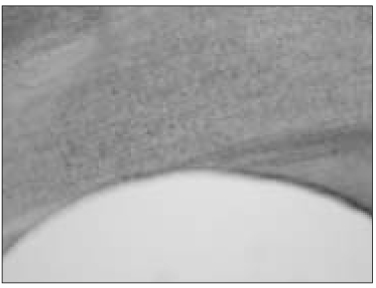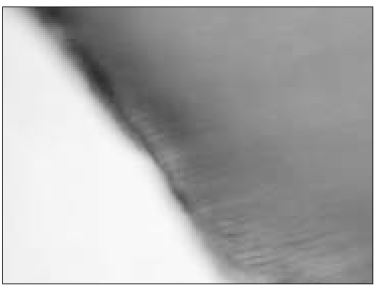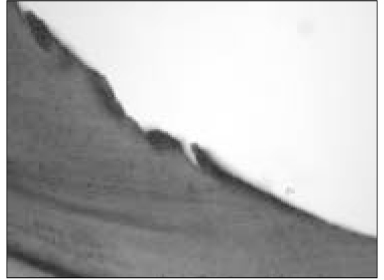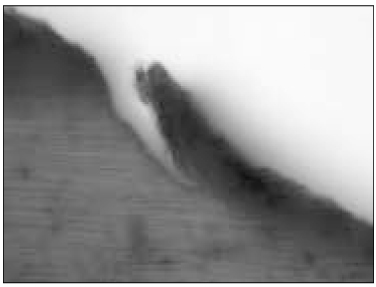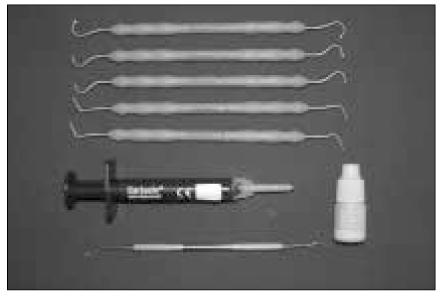J Korean Acad Conserv Dent.
2005 May;30(3):149-157. 10.5395/JKACD.2005.30.3.149.
The efficacy of chemo-mechanical removal of dentin carious lesion
- Affiliations
-
- 1Department of Conservative Dentistry, Division of Dentistry, Graduate School, Kyunghee University, Korea. psangjin@khu.ac.kr
- 2Oral Biology Research Institute, College of Dentistry, Kyunghee University, Korea.
- KMID: 2045240
- DOI: http://doi.org/10.5395/JKACD.2005.30.3.149
Abstract
- Mechanical removals in decayed teeth have been performed using drill and sharp hand instruments. These methods have some disadvantages such as pain, local anesthesia and overextended cavities. Therefore chemo-mechanical excavation of dentin carious lesions has been introduced. The purpose of this study was to evaluate the efficacy of traditional mechanical methods using burs and chemo-mechanical methods (Carisolv) of caries dentin. Mechanical caries removal was carried with low speed round bur. Chemo-mechanical caries excavation was performed with Carisolv (Medi-team), using the Carisolv hand instruments. The mean time to remove caries with two different methods was evaluated and the data analyzed with SPSS software (ver 11.5) by t-test (p < 0.05). For histomorphometry of caries removal were also carried with mechanical or chemo-mechanical (Carisolv) methods from 20 extracted caries permanent molars. Complete caries removal was verified with a #23 sharp explorers, Caries Detector (Kuraray Co. Japan), and standard apical radiography. 1. Chemo-mechanical method was taken more times than mechanical method (1.5 fold) (p < 0.05). 2. Excavation for caries took more time for molar lesion than premolar lesion, and the least time was taken to remove the caries in incisor lesion (p < 0.05). 3. There were no significant differences to remove the caries between the maxilla and mandible (p > 0.05). 4. The remaining carious dentin was detected after the chemo-mechanical removal of the carious dentin, and no smear layer were seen after the mechanical and chemo-mechanical removal of the carious dentin.
Keyword
MeSH Terms
Figure
Reference
-
1. Banerjee A, Kidd E, Watson T. In vitro evaluation of five alternative methods of carious dentine excavation. Caries Res. 2000. 34:144–150.
Article2. Banerjee A, Kidd E, Watson T. Scanning electron microscopic observations of human dentine after mechanical caries excavation. J Dent. 2000. 28:179–186.
Article3. Yamada Y, Hossain M, Kawanaka T, Kinoshita J, Matsumoto K. Removal effects of the Nd:YAG laser and Carisolv on carious dentin. J Clin Laser Med Surg. 2000. 18:241–245.
Article4. Yamada Y, Hossain M, Suzuki N, Kinoshita JI, Nakamura Y, Matsumoto K. Removal of carious dentin by Er: YAG laser irradiation with and without carisolv. J Clin Laser Med Surg. 2001. 19:127–131.
Article5. Beeley JA, Yip HK, Stevenson AG. Chemochemical caries removal a review of the techniques and latest developments. Br Dent J. 2000. 188:427–430.
Article6. Ericson D, Zimmerman M, Raber H, Gotrick B, Bornstein R, Thorell J. Clinical evaluation of efficacy and safety of a new method for chemo-mechanical removal of caries. A multi-centre study. Caries Res. 1999. 33:171–177.
Article7. Chaussain-Miller C, Decup F, Domejean-Orliaguet S, Gillet D, Guigand M, Kaleka R, Laboux O, Lafont J, Medioni E, Serfaty R, Toumelin-Chemla F, Tubiana J, Lasfargues J. Clinical evaluation of the Carisolv chemomechanical caries removal technique according to the site/stage concept, a revised caries classification system. Clin Oral Investig. 2003. 7:32–37.
Article8. Munshi AK, Hegde AM, Shetty PK. Clinical evaluation of Carisolv in the chemico-mechanical removal of carious dentin. J Clin Pediatr Dent. 2001. 26:49–54.
Article9. Hannig M. Effect of Carisolv™ solution on sound, demineralized and denatured dentin - an ultrastructural investigation. Clin Oral Investig. 1999. 3:155–159.
Article10. Kakaboura A, Masouras C, Staikou O, Vougiouklakis G. A comparative clinical study on the Carisolv caries removal method. Quintessence Int. 2003. 34:269–271.11. Splieth C, Rosin M, Gellissen B. Determination of residual dentine caries after conventional mechanical and chemomechanical caries removal with Carisolv. Clin Oral Investig. 2001. 5:250–253.
Article12. Maragakis GM, Hahn P, Hellwig E. Clinical evaluation of chemo-mechanical caries removal in primary molars and its acceptance by patients. Caries Res. 2001. 35:205–210.
Article13. Nadanovsky P, Cohen Carneiro F, Souza de Mello F. Removal of caries using only hand instruments: a comparison of mechanical and chemo-mechanical methods. Caries Res. 2001. 35:384–389.
Article14. Fure S, Lingstrom P, Birkhed D. Evaluation of Carisolv for the chemo-mechanical removal of primary root caries in vivo. Caries Res. 2000. 34:275–280.
Article15. Wennerberg A, Sawase T, Kultje C. The influence of Carisolv on enamel and dentine surface topography. Eur J Oral Sci. 1999. 107:297–306.16. Arvidsson A, Liedberg B, Möller K, Lyvén B, Sellén A, Wennerberg A. Chemical and topographical analyses of dentine surfaces after Carisolv™ treatment. J Dent. 2002. 30:67–75.
Article17. Haak R, Witch MJ, Noack MJ. Does chemo-mechanical caries removal affect dentine adhesion? Eur J Oral Sci. 2000. 108:449–455.
Article18. Cederlund A, Lindskog S, Blomlof J. Effect of a chemomechanical caries removal system (Carisolv) on dentin topography of non-carious dentin. Acta Odontol Scand. 1999. 57:185–189.
Article19. Cederlund A, Lindskog S, Blomlof J. Efficacy of Carisolv-Assisted caries excavation. Int J Periodontics Restorative Dent. 1999. 19:464–469.20. Dammaschk T, Stratmann U, Mokrys K, Kaup M, Ott K. Histocytological evaluation of the reaction of rat pulp tissue to Carisolv. J Dent. 2001. 29:283–290.
Article
- Full Text Links
- Actions
-
Cited
- CITED
-
- Close
- Share
- Similar articles
-
- Comparative efficacy of photo-activated disinfection and calcium hydroxide for disinfection of remaining carious dentin in deep cavities: a clinical study
- Effect of dentin roughening and type of composite material on the restoration of non-carious cervical lesions: an in vivo study with 18 months of follow-up
- New treatment method for pain and reduction of local anesthesia use in deep caries
- Effective Management of Multiple Non-carious Cervical Lesions with Gingival Recession and Dentin Hypersensitivity: Two Cases Report of Combined Restorative and Periodontal Approach
- Update on dentin hypersensitivity: with the focus on hydrodynamic theory and mechanosensitive ion channels



